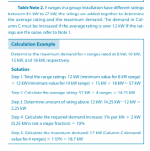Larry Bohn
Member
- Location
- ashland, oregon
I've been wondering why note 2 to T.220.55 references ranges "Over 8-3/4 KW through 27KW" ranges. excluding those ranges below 8-3/4KW. The example calculation included in the codebook for note 2 includes an 8KW range, raising its minimum KW to 12KW. How can they do this and still comply with the rules of the note? I'm perplexed. Can anyone explain this, or is it a mistake in the book?


